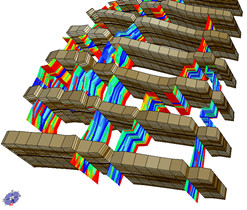A huge amount of R&D has been conducted with the aim of increasing industry's ability to predict and model fault-related fluid flow within siliciclastic reservoirs. For example, large databases now exist on the architecture and fluid flow properties of faults in siliciclastic reservoirs. Software tools, such as TransGen and TrapTester, are now routinely used throughout industry to use these data to improve modelling of fault-related barriers in siliciclastic reservoirs.
Similar tools and datasets are not, however, available for assessing the impact of faults on fluid flow within carbonate reservoirs. This represents a major omission given that carbonate reservoirs are equally, if not more, important than siliciclastic reservoirs. Indeed, it is worth noting that many shale gas resource plays are carbonate rich. To fill this knowledge gap the University of Leeds and Badley Geoscience Ltd and created a research group that will
- Build a database of the petrophysical properties of fault rocks in petroleum reservoirs;
- Document examples of how faults affect fluid flow in carbonate reservoirs;
- Develop a software tool that will link to TransGen/TrapTester to improve the ability of industry to model fault-related fluid flow in carbonate reservoirs.



